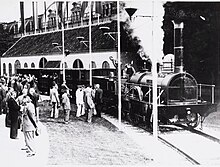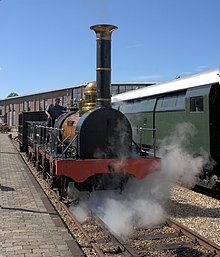De Arend (locomotive)
| Arend and Leeuw | |||||||||||||||||||||||||||||||||||||||||
|---|---|---|---|---|---|---|---|---|---|---|---|---|---|---|---|---|---|---|---|---|---|---|---|---|---|---|---|---|---|---|---|---|---|---|---|---|---|---|---|---|---|
 The 1939-built De Arend replica | |||||||||||||||||||||||||||||||||||||||||
| |||||||||||||||||||||||||||||||||||||||||
| |||||||||||||||||||||||||||||||||||||||||
| |||||||||||||||||||||||||||||||||||||||||
| |||||||||||||||||||||||||||||||||||||||||
De Arend (Dutch pronunciation: [də ˈʔaːrənt]; the eagle) was one of the two first steam locomotives in the Netherlands. It was a 2-2-2 Patentee type built in England by R. B. Longridge and Company of Bedlington, Northumberland to run on the then standard Dutch track gauge of 1,945 mm (6 ft 4+9⁄16 in). On 20 September 1839, together with the Snelheid (Dutch for speed), it hauled the first train of the Hollandsche IJzeren Spoorweg-Maatschappij between Amsterdam and Haarlem. It was withdrawn in 1857.
In 1939 a replica of the De Arend was constructed for the 100th anniversary of the Dutch railways. It is displayed at the Nederlands Spoorwegmuseum (Dutch Railway Museum) in Utrecht.
History
[edit]The Hollandsche IJzeren Spoorweg-Maatschappij (HSM), founded in 1837, ordered four locomotives from the R.B. Longridge & Co works at Bedlington in July 1838, of the Stephenson patented Patentee type with the axle layout 1A1, which were named Snelheid, De Arend, Hoop and Leeuw. The De Arend and Leeuw were similar to each other, but differed from the Snelheid and Hoop in several respects.


.
In May 1839, the Snelheid was delivered first, after which the first trial runs were carried out with that machine. With the delivery of the De Arend in early September 1839, train service could be started. The opening runs took place on 20 and 21 September 1839, with regular service commencing on 24 September 1839. The Lion was delivered as the fourth locomotive on 26 December 1839.
The De Arend and Leeuw served the entire HSM broad gauge line, which was extended to Leiden in 1842, to The Hague in 1843 and to Rotterdam in 1847.
In 1848, it appeared that the condition of the Hoop had become poor, and it was suggested that this locomotive be used as a supplier of spare parts ('pick loco') for the Snelheid. A similar plan was also drawn up for the R3 Arend and the Leeuw. Due to the bad experiences with the Leiden locomotive and the cancellation of two locomotives similar to it, there would be no replacement locomotives for the pick locomotives to be set aside. It was then decided to completely overhaul the four oldest locomotives. After overhauling the Speed and the Hoop in 1848 and 1849, the Leeuw and the Arend were overhauled in 1850 and 1851 respectively.
After the railway of the Nederlandsche Rhijnspoorweg-Maatschappij (NRS) had been converted from broad gauge to 1,435 mm (4 ft 8+1⁄2 in) standard gauge in the period 1854-1855, the HSM tried to take over some of the younger broad gauge locomotives that had become redundant at the NRS, to replace the oldest of its own locomotives. However, the NRS had already sold them to the dealer B.J. Nijkerk in Amsterdam. With this trader, the HSM agreed to swap twelve locomotives with an additional payment of 2,000 guilders per locomotive. In 1856, the ‘’Leeuw‘’ was exchanged for the younger ex-NSR locomotive 16 ‘’Bromo‘’. The ‘’Bromo‘’ was immediately rejected and delivered back to the contractor. In 1857, the ‘’De Arend‘’ was exchanged for the NRS 12 ‘’Vesusius‘’, which served the HSM until 1863. All the aforementioned locomotives were subsequently scrapped.
In 1939, Hildo Krop chiselled ‘’D'Arend‘’ out in granite for his sculpture ‘’The development of the locomotive‘’, a keystone for the Weesperpoortbrug in Amsterdam.
Replica
[edit]
In 1938, the Central Workshop in Zwolle built a replica on the occasion of the centenary of the railways in the Netherlands. Of twin locomotive the ‘’Lion‘’, the original drawings had survived, with which a replica was made of the ‘’Arend‘’, which had been delivered to the HSM as the second locomotive. Together with three also reconstructed matching passenger carriages (3rd class no. 10 ‘’waggon‘’, 2nd class no. 8 ‘’char à bancs‘’ and 1st class no. 4 ‘’diligence‘’), the locomotive was used in filming for the film ‘’100 years of railways in the Netherlands‘’ at Hoofddorp Station.[1][2]


In the summer of 1939, the Arend drove around the exhibition grounds set up for the celebration of the centenary of the railways at Frederiksplein in Amsterdam. For ten cents, people could ride along for two rounds. At least 100,000 people took advantage of this opportunity; the train covered about 3,000 kilometres (1,900 mi) on the grounds.[2] Afterwards, the locomotive was stored in a shed near the workshop in Zwolle. There, the second ‘’Arend‘’ survived the destruction of Zwolle yard in 1945 by a German Sprengkommando.[2][3]
In 1948, the locomotive and carriages were brought to Delft for the 100-year anniversary of the Delftsch Studenten Corps. The student fraternity was located on the Phoenixstraat, where a third rail was installed alongside the track of the tramlijn Den Haag-Delft over a length of 950 metres (1,040 yd). 13,000 people took a ride for 15 cents.[2]
From 21 August to 1 September 1951, the train ran in Enschede, where the exhibition ‘’FF (fecerunt fortissimo)‘’ was held in the Volkspark. Of the 210,000 visitors, 20,000 took a ride on the train.[2]
After two years in the locomotive shed in Hoorn, the train was incorporated into the newly opened Nederlands Spoorwegmuseum in Utrecht Maliebaan Station in 1953, where it has had its home base ever since.
During the event ‘’Treinen door de Tijd‘’, on the occasion of the 150th anniversary of the railways in the Netherlands in 1989, the Dez Arend made its rounds on the exhibition grounds at the Utrechtse Jaarbeurs. The train then returned to the Railway Museum, Since 1989 it has been in service to run steam-powered rides on the museum grounds.
From 22 August to 26 October 1997, the De Arend was visiting Switzerland due to the 150th anniversary of the Swiss Railways.[2]
From 18 June to 27 June 1999, the De Arend was a guest in the US at the 1999 Railfair at the California State Railroad Museum in Sacramento.
On 20 September 2014, the De Arend was used in front of Amsterdam Centraal station as part of the theatre show ‘Als de dag van Toen’, to mark the 175th anniversary of the railways in the Netherlands. The locomotive was not running at the time, but the effect was created with a moving canvas that showed a landscape.
In 2016, the Municipality of Amsterdam bridge 1763 named after the locomotive
Broad gauge at the Railway Museum
[edit]Since 2005 there has also been a piece of 1945 mm broad gauge track for the locomotive De Arend on the premises of the Railway Museum. As part of the 175th anniversary of the railways in the Netherlands, this broad gauge track was extended at the railway yard on 19 July 2014. This broad gauge track was largely constructed as a three-rail track and allows for the running of the existing broad gauge rolling stock on special occasions.[4] The De Arend has been at its permanent location since 2005, with two of its carriages (8 and 10), part of the attraction ‘’The Great Discovery‘
| Factory number | Name | In service | Out of service! | Details |
|---|---|---|---|---|
| 119 | De Arend | 1839 | 1857 | Swapped for NRS 12 ‘’Vesuvius‘’. |
| 125 | Leeuw | 1839 | 1856 | Swapped against NRS 16 ‘’Bromo‘’, rejected immediately. |
| Factory number | Name | In service | Out of service! | Details |
| 30 | The De Arend (replica) | 1939 | Included in the collection of the Nederlands Spoorwegmuseum. |
Broad gauge at the Railway Museum
[edit]Since 2005 there has also been a piece of 1945 mm broad gauge track for the locomotive De Arend on the premises of the Railway Museum. As part of the 175th anniversary of the railways in the Netherlands, this broad gauge track was extended at the railway yard on 19 July 2014. This broad gauge track was largely constructed as a three-rail track and allows for the running of the existing broad gauge rolling stock on special occasions.[4] The De Arend has been at its permanent location since 2005, with two of its carriages (8 and 10), part of the attraction ‘’The Great Discovery‘
| Factory number | Name | In service | Out of service! | Details |
|---|---|---|---|---|
| 119 | De Arend | 1839 | 1857 | Swapped for NRS 12 ‘’Vesuvius‘’. |
| 125 | Leeuw | 1839 | 1856 | Swapped against NRS 16 ‘’Bromo‘’, rejected immediately. |
| Factory number | Name | In service | Out of service! | Details |
| 30 | The De Arend (replica) | 1939 | Included in the collection of the Nederlands Spoorwegmuseum. |
See also
[edit]Literature
[edit]- R.C. Statius Muller, A.J. Veenendaal jr., H. Waldorp: De Nederlandse stoomlocomotieven. Uitg. De Alk, Alkmaar, 2005. ISBN 90 6013 262 9
- J. van der Meer: De Hollandsche IJzeren Spoorweg-Maatschappij. Uitg. Uquilair, 2009, ISBN 978 90 71513 68 8
- J.J. Karskens: De Locomotieven van de Hollandsche IJzeren Spoorweg Maatschappij. Uitg. J.H. Gottmer, Haarlem - Antwerpen, 1947
- G.F. van Reeuwijk: De breedspoorlokomotieven van de H.IJ.S.M.. Uitg. De Alk, Alkmaar, 1985, ISBN 90 6013 927 5.
References
[edit]- ^ Hundred Years of Railways in the Netherlands 1839 - 1939 Archived on 1 March 2020.
- ^ a b c d e f NVBS: Op de Rails. Ockeloen, Max: The fate of the NS exhibition train of the year 1939. 1988(1).
- ^ Huurman, C. (2001), The railway company in wartime. 's-Hertogenbosch: Publisher Uquilair.
- ^ a b [1] Archived on 20 December 2021.
- Statius Muller, R.C.; Veenendaal, A.J. Jr.; Waldorp, H. (2005). De Nederlandse stoomlocomotieven (in Dutch). Alkmaar: Uitg. De Alk. ISBN 90-6013-262-9.
- Waldorp, H. (1981). Onze Nederlandse stoomlocomotieven in woord en beeld. Alkmaar: De Alk. pp. 21–22. ISBN 90-6013-909-7.
External links
[edit]- De Arend op de Nederlandse Museummaterieel Database
- De reconstructie van de eerste treinrit in Nederland - Max de Haas en 100 jaar spoorwegen in Nederland (1939) - video, www.anderetijden.nl
- Tijdens het evenement ter ere van 150 jaar spoorwegen in Nederland reed lok 'de arend'zijn rondjes op het tentoonstellingsterrein. - video
- De Arend rijdt heen en weer op het terrein van het Spoorwegmuseum. - video
- Geluid van stoomlocomotief De Arend te Utrecht 1989 - geluidsopname
